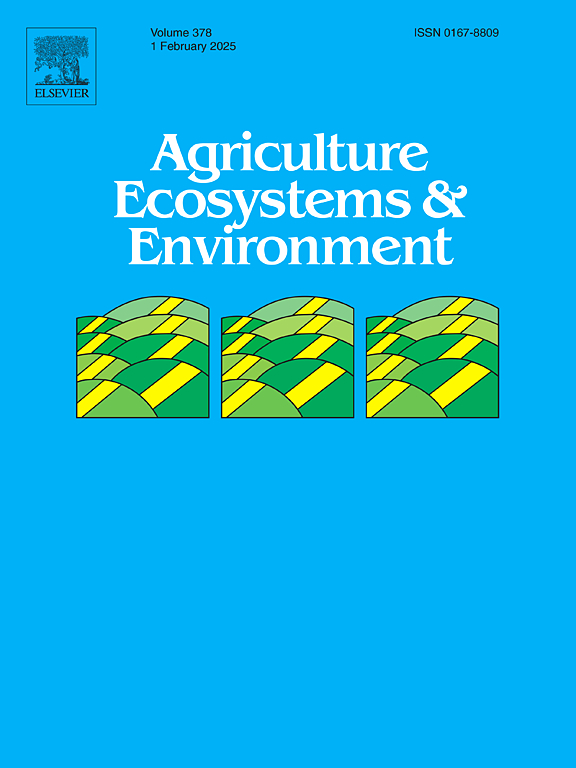低碳氮比作物秸秆还田可实现减少甲烷排放和提高产量稳定性的双重效益
IF 6
1区 农林科学
Q1 AGRICULTURE, MULTIDISCIPLINARY
引用次数: 0
摘要
旱稻轮作与秸秆还田相结合是中国亚热带地区的普遍做法。然而,不同旱稻轮作制度下旱稻残茬还田对水稻季甲烷(CH₄)排放的影响及其机制尚缺乏研究。为此,一项为期两年的田间试验(2023-2024年)比较了四川盆地五种最流行的轮作系统:小麦-水稻、油菜籽-水稻、绿色蔬菜-水稻、紫穗槐-水稻和休耕水稻。测定了nh4排放量、水稻产量、温室气体强度以及土壤产甲烷和产甲烷基因丰度。旱季作物得到不同的肥料投入,而水稻季节管理保持统一。结果表明:小麦-水稻在水稻生育期具有最高的产甲烷基因丰度(分别在2023年和2024年为5.00 × 10⁷和2.27 × 10⁷拷贝g -⁻¹土壤),这是由于高碳氮比的秸秆投入(43.91),这增强了产甲烷菌活性,导致最大的累积CH₄排放量(683.41和238.65 kg hm⁻²)和更高的水稻产量(7741.83和8231.04 kg hm⁻²)。因此,小麦-水稻的温室气体强度(2.22和0.74 kg CO₂-eq kg⁻¹粮食产量)显著高于其他系统。相比之下,低碳氮比秸秆(11.28)与小麦-水稻轮作(147.56和39.55 kg hm -⁻²)相比,通过平衡产甲烷和产甲烷的基因丰度(0.61-1.19),减少了累积的甲烷排放量,同时保持了稳定的产量(7668.22-8614.37 kg hm -⁻²)。青菜稻轮作系统的产量(8117.98和9203.85 kg hm⁻²)与青菜稻轮作系统的产量差异不显著(p < 0.05),且高于其他轮作系统。值得注意的是,通过协同优化碳氮动力学和土壤有机碳固汇,紫水稻实现了最低的温室气体强度(0.48-0.12 kg CO₂-eq kg⁻¹)。综上所述,在稳产和减排方面,紫穗槐-水稻轮作制度具有较好的效果。本研究强调了秸秆碳氮比在调节甲烷代谢和维持碳氮平衡中起着关键作用,从而为水稻种植提供了气候智能型策略。它为优化作物轮作系统提供了坚实的科学基础,并有助于减少农业温室气体排放。本文章由计算机程序翻译,如有差异,请以英文原文为准。
Returning low C/N crop straw to the paddy field can achieve the dual benefits of reduced methane emissions and enhanced yield stability
The combination of upland-paddy rotation and straw returning is a common practice in China's subtropical regions. However, the effect and mechanisms of returning the upland crop residues to the paddy field on methane (CH₄) emissions during the rice (Oryza sativa L.) season under different upland-paddy rotation systems remain scarce. To this end, a two-year field experiment (2023–2024) compared five of the most popular rotation systems: wheat-rice, rapeseed-rice, green vegetable-rice, Vicia villosa var.-rice, and fallow-rice in the Sichuan Basin. CH₄ emissions, rice yields, greenhouse gas intensity, and soil methanogenic and methanotrophic gene abundances were measured. Dry-season crops received distinct fertilizer inputs, while rice-season management remained uniform. The results showed that: wheat-rice had the highest abundance of the methanogenic gene (5.00 × 10⁷ and 2.27 × 10⁷ copies g⁻¹ soil in 2023 and 2024, respectively) during the rice growth period, resulting from high carbon-to-nitrogen ratio straw inputs (43.91), which enhanced methanogen activity, leading to the largest cumulative CH₄ emissions (683.41 and 238.65 kg hm⁻²) and higher rice yields (7741.83 and 8231.04 kg hm⁻²). Therefore, the greenhouse gas intensity of wheat-rice (2.22 and 0.74 kg CO₂-eq kg⁻¹ grain yield) was significantly higher than that of other systems. In contrast, the Vicia villosa var.-rice (147.56 and 39.55 kg hm⁻²) rotation with low carbon-to-nitrogen ratio straw (11.28) reduced cumulative CH₄ emissions compared to wheat-rice through balancing methanogenic and methanotrophic gene abundances (ratio 0.61–1.19), while maintaining stable yields (7668.22–8614.37 kg hm⁻²). The yield of the Vicia villosa var.-rice rotation system was not significantly different from green vegetable-rice (8117.98 and 9203.85 kg hm⁻²) and was higher than that of the other systems. Notably, Vicia villosa var.-rice achieved the lowest greenhouse gas intensity (0.48–0.12 kg CO₂-eq kg⁻¹) by synergistically optimizing carbon-nitrogen dynamics and soil organic carbon sequestration. The above results indicate that the Vicia villosa var.-rice rotation system exhibits superior performance in terms of stable yield and emission reduction. This study highlights that the straw carbon-to-nitrogen ratio plays a pivotal role in regulating methane metabolism and maintaining carbon-nitrogen balance, thereby presenting a climate-smart strategy for rice cultivation. It provides a robust scientific foundation for optimizing crop rotation systems and contributes to mitigating agricultural greenhouse gas emissions.
求助全文
通过发布文献求助,成功后即可免费获取论文全文。
去求助
来源期刊

Agriculture, Ecosystems & Environment
环境科学-环境科学
CiteScore
11.70
自引率
9.10%
发文量
392
审稿时长
26 days
期刊介绍:
Agriculture, Ecosystems and Environment publishes scientific articles dealing with the interface between agroecosystems and the natural environment, specifically how agriculture influences the environment and how changes in that environment impact agroecosystems. Preference is given to papers from experimental and observational research at the field, system or landscape level, from studies that enhance our understanding of processes using data-based biophysical modelling, and papers that bridge scientific disciplines and integrate knowledge. All papers should be placed in an international or wide comparative context.
 求助内容:
求助内容: 应助结果提醒方式:
应助结果提醒方式:


